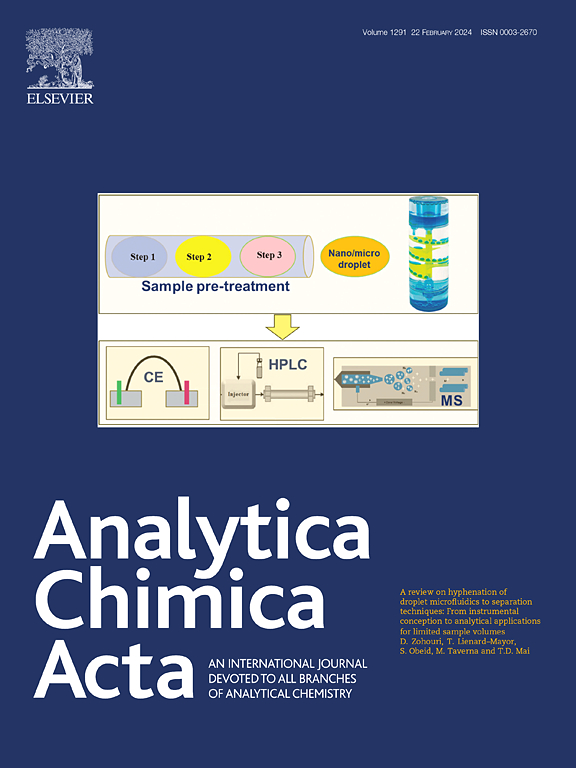合理设计一种近红外荧光探针,用于快速监测活细胞和药物性肝损伤小鼠的羧酸酯酶
IF 6
2区 化学
Q1 CHEMISTRY, ANALYTICAL
引用次数: 0
摘要
羧酸酯酶(carboxylesterase, CE)是一种重要的酶,主要存在于肝细胞中,可以催化多种药物和外源性药物中的酯类水解。CE的实时无创成像对CE相关代谢性疾病的研究具有重要意义。虽然荧光传感技术被认为是一种很有前途的候选技术,但其响应速度慢(≤60 min)、灵敏度低、发射波长短(<;650 nm)的波长限制了大多数CE探针的实际应用。因此,开发新型荧光探针对ce相关疾病的快速诊断具有重要意义和紧迫性。结果在荧光团中引入乙酰基作为CE识别单元,制备了一种近红外荧光探针CF3-BDP-CE,用于CE检测。CF3-BDP-CE在690 nm处表现出明显的荧光增强,检出限为7.9×10-4 U/mL。重要的是,快速的响应动力学(在3分钟内)使CF3-BDP-CE优于大多数报道的探针。理论计算证实了CF3-BDP-CE的发射开启机理,揭示了CF3-BDP-CE水解后,分子内电荷转移过程产生了强荧光。此外,CF3-BDP-CE已成功应用于活细胞内源性CE变化的实时成像以及肿瘤与正常细胞之间CE活性差异的成像。此外,CF3-BDP-CE已成功用于追踪对乙酰氨基酚诱导的肝损伤模型小鼠的CE异常。研究发现CF3-BDP-CE近红外荧光探针可有效跟踪活细胞和小鼠体内CE波动的动态变化,在CE相关疾病的诊断中具有潜在的应用价值。本文章由计算机程序翻译,如有差异,请以英文原文为准。


Rational design of a near-infrared fluorescent probe for rapid monitoring of carboxylesterase in live cells and drug-induced liver injury mice
Background
Carboxylesterase (CE) is an important enzyme that mainly exists in liver cells and can catalyze the hydrolysis of esters in a variety of pharmaceuticals and xenobiotics. Real-time and non-invasive imaging of CE is of great significance for the study of CE-related metabolic diseases. Although fluorescence sensing technology is considered a promising candidate, the slow response rate (> 60 min), low sensitivity, and short emission wavelength (<650 nm) of most CE probes limit their practical application. Therefore, it is significant and urgent to develop novel fluorescent probes for the rapid diagnosis of CE-related diseases.
Results
Herein, a near-infrared fluorescent probe, CF3-BDP-CE, has been developed by introducing acetyl as the CE recognition unit into the fluorophore meso-trifluoromethyl-BODIP for the detection of CE. CF3-BDP-CE exhibited a remarkable fluorescence enhancement at 690 nm for CE with a limit of detection of 7.9 × 10−4 U/mL. Importantly, the fast response kinetics (within 3 min) make CF3-BDP-CE superior to most reported probes. The emission turn-on mechanism was confirmed by theoretical calculation, revealing that after the hydrolysis of CF3-BDP-CE, the intramolecular charge transfer process leads to strong fluorescence. Furthermore, CF3-BDP-CE has been successfully applied to real-time imaging of endogenous CE changes in living cells and to imaging CE activity differences between tumor and normal cells. In addition, CF3-BDP-CE has been successfully used to track CE abnormalities in acetaminophen-induced liver injury model mice.
Significance
A NIR fluorescent probe CF3-BDP-CE was developed to effectively track the dynamic change of CE fluctuation in living cells and mice, with potential applications in the diagnosis of CE-related diseases.
求助全文
通过发布文献求助,成功后即可免费获取论文全文。
去求助
来源期刊

Analytica Chimica Acta
化学-分析化学
CiteScore
10.40
自引率
6.50%
发文量
1081
审稿时长
38 days
期刊介绍:
Analytica Chimica Acta has an open access mirror journal Analytica Chimica Acta: X, sharing the same aims and scope, editorial team, submission system and rigorous peer review.
Analytica Chimica Acta provides a forum for the rapid publication of original research, and critical, comprehensive reviews dealing with all aspects of fundamental and applied modern analytical chemistry. The journal welcomes the submission of research papers which report studies concerning the development of new and significant analytical methodologies. In determining the suitability of submitted articles for publication, particular scrutiny will be placed on the degree of novelty and impact of the research and the extent to which it adds to the existing body of knowledge in analytical chemistry.
 求助内容:
求助内容: 应助结果提醒方式:
应助结果提醒方式:


